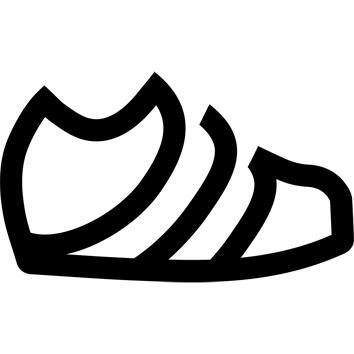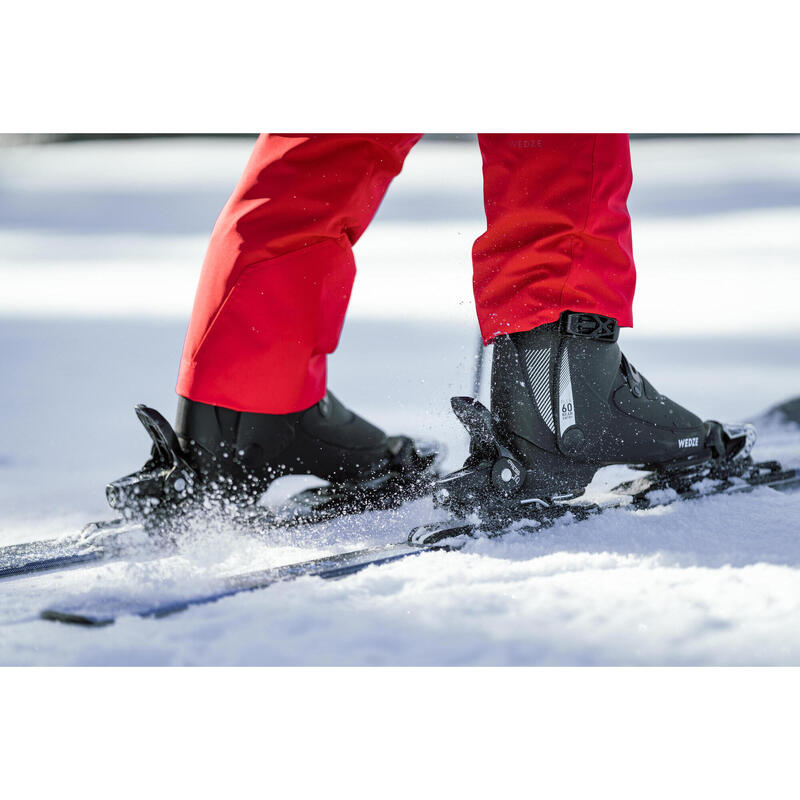Experience
The 100 is designed for the beginner or recreational skier looking for ease of use. Its rear-entry construction offers unrivalled ease of donning and doffing, as well as easy adjustment with its single buckle.
It offers maximum flexibility for maximum tolerance when learning to ski. Walking is made easier thanks to the unlocked rear section, offering a wide ankle range. Generous volume for guaranteed comfort.
Hook adjustment
Its single buckle allows tightening in a matter of seconds, compared to a conventional shoe with 3 or 4 hooks and a strap.
To tighten, simply pull on the buckle until the desired pressure is reached.
To walk, simply release the buckle by a few notches to offer more ankle amplitude.
To loosen, simply release the rack completely to benefit from a very large opening, so that the foot can be lifted out easily without bending down.
Shoeing/Unshoeing
The rear-entry design allows the shell to be opened wide for putting on or taking off your foot. There's no need to bend down, force or pull hard on the tongue to get your foot in. It's just as easy to put on in the cold, whereas conventional shoes are much harder to put on in sub-zero temperatures.
WHAT IS FLEX?
To give an indication of the shoe's rigidity, brands define a Flex index for each shoe. This number determines the boot's rigidity: the higher the value, the stiffer the shell. A flex of 60 to 70 is considered suitable for beginners. A flex of 70 to 100 is for advanced skiers. Beyond that, products are designed for expert skiers. However, larger skiers can move up a level.
How do you know if the shoe you're trying on is the right size?
With your foot in the shoe, close the hooks halfway. Can you go any further? This means that the shoe's volume doesn't suit you. Once your shoes are closed, perform 3 flexions. Stand up straight: Your toes should touch the toe of the shoe. As you flex, your foot should move backwards and you should no longer feel the toe. Bear in mind, too, that after a few days' skiing, the boot's foam will settle.
What to do about foot pain
1- Choose a thin, technical ski sock to avoid pressure points and promote blood circulation in the foot.
2- Choose a sole adapted to the shape of your foot to prevent it from crushing against the shell. Ask a sales assistant for advice.
How do I store my ski boots?
1- Aerate your shoes by removing the liner inside the plastic shells.
2- Close the hooks at the first notch to prevent the shoes from deforming and, if possible, store them in a cover.
3- Store them, if possible, in a dry place where the temperature is unlikely to fall below 10°C. The shoe's plastic will thank you!
How do I try on a ski boot?
Once the foot is in the shoe, close the hooks halfway. Can you go any further? This means that the shoe's volume doesn't suit you. Once your shoes are closed, perform 3 large flexions by pressing hard on your shins (put your hands on your knees) to move your heel back into the shoe. Stand up straight: you should be able to touch the tip of the shell. When flexing, your foot should move backwards and you should no longer be able to feel the toe.
How do you keep your feet warm?
Often overlooked, drying the liner is the most important step in keeping feet warm. Even at -10°C, the foot perspires and the liner can't dry on its own in its plastic shell, even over several days. Ideally, you should take them out every day. You can also use shoe dryers, which are much more practical, as you don't need to take the slipper out - just plug them in!










